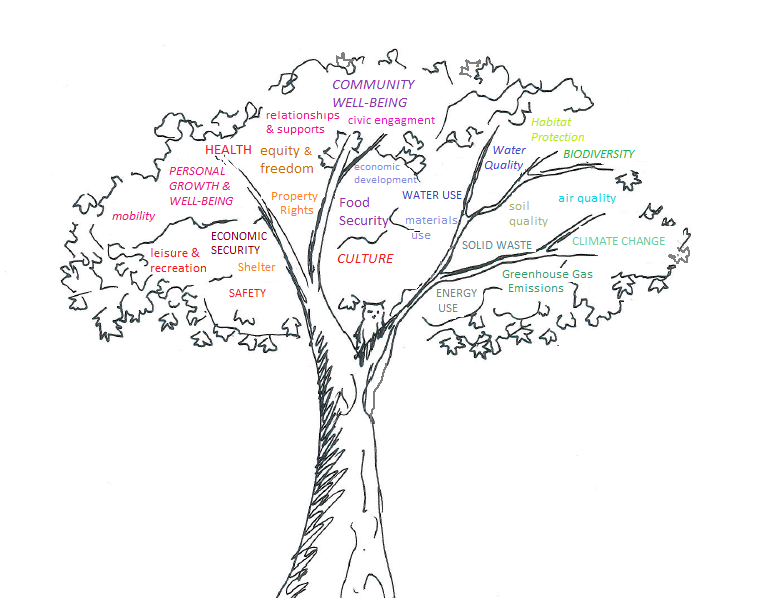The following is a preview of the Impact Mapping Worksheet. For complete worksheet features, please download the worksheet file on the left hand side.
Table of Contents
Basic Mapping: Key Strategies, Objectives, Outcomes
Going Further: Detailed Mapping of Your Mission
Introduction
About this Worksheet
This worksheet will help you describe your social, environmental and/or cultural mission in more detail to be able to better select indicators to monitor your community impact.
How to Use
The first sheet, 'Basic Mapping' asks you to more clearly describe the activities you do to make a difference, and what that difference will look like. 'Go Further' describes methods you can use to map out connections between your activities and what you want to accomplish with your mission. Templates are provided for three different mapping methods.
Basic Mapping: Key Strategies, Objectives, Outcomes
Describe your outcomes
The value you create through your mission can be multifaceted. The table below can help you fully identify all of the ways you create value as an organization, in ways you haven't thought about before. To use this worksheet, scan the areas below. If you specifically undertake activities in this area and/or see changes in the people and community you work with, describe them. It may also be useful to visualize this using the Community Impact Tree image below. Find the words that you associate with your impact, and look at the other branches nearby to brainstorm other impacts.

Fill out only what applies.
Social, Economic, Cultural
| Areas | What this includes | Describe specific value you create in this area | Describe any activities you do that specifically support these outcomes |
| Safety |
| ||
| Shelter |
| ||
| Economic Security |
| ||
| Food Security |
| ||
| Mobility |
| ||
| Personal Growth and Well-being |
| ||
| Health |
| ||
| Relationships and Supports |
| ||
| Leisure and Recreation |
| ||
| Equity and Freedom |
| ||
| Property Rights |
| ||
| Culture |
| ||
| Economic Development |
| ||
| Civic Engagement |
|
Environmental
| Areas | What this includes | Describe specific outcomes you see (or want to see) in the people and community you work with | Describe any activities you do that specifically support these outcomes |
| Materials Use |
| ||
| Energy Use |
| ||
| Water |
| ||
| Greenhouse Gas Emissions / Climate Change |
| ||
| Air Quality | Decrease in:
Improvements in:
| ||
| Waste |
| ||
| Biodiversity / Habitat Protection |
| ||
| Soil Quality |
|
Going Further: Detailed Mapping of Your Mission
Map the connections
You can take the work that you did in the basic mapping by going further to specify how your activities will make a difference, in other words - mapping the relationships between what you do and the long-term outcomes you want to see. This can be very useful for 1. planning, 2. for guiding what you monitor and 3. for communicating your impact. There are a number of different approaches, and excellent on-line l resources to help you with this. Choose a mapping method that suites you. Most are geared to programs, but are equally relevant to social enterprises.
| Type of Map | Description / Use | Resources |
| Logic Model | Graphical listing of activities and desired outcomes in a logical flow form. This includes: Inputs - what you need to accomplish activities, Activities, Outputs - evidence of delivering activates, Outcomes | University of Wisconsin Extension Logic Model Development Social Enterprise Partnership (UK) Prove and Improve |
| Outcome Mapping | Similar to a Logic model, except you define more clearly who you want to influence and how, and include those people in the change that you map. | Outcome Mapping Learning Community |
| Theory of Change | You clearly describe how social/environmental/cultural change can occur from the activities that you control to your ultimate desired outcome. | ActKnowledge / The Aspen Institute Roundtable on Community Change Theory of Change |
Logic Model
| Inputs - What you will need to accomplish your activities | Activities - what you will be doing to address the problem | Outputs - evidence of delivering your activities | Outcomes - the changes your activities will lead to | |||
| short term 1-3 years | mid-term 3-5 years | long-term | ||||
Assumptions | External Factors |
Outcome Mapping
Describe the world in which your social and/or environmental objectives are realized. How is the community transformed? How are people different? How is the natural world and environment transformed?
How do people change?
| Describe the people and organizations you want to affect and influence | Describe how they would be different in the ideal world you described above. | Describe how their behaviour, actions and relationships change to get to this ideal world. | Describe the strategies you have that are directed at these changes | Describe other factors that could influence this change | |
| Easier changes | Harder Changes | ||||
Theory of Change
Developing a detailed theories of change allows you to think through the assumptions you are making that would lead from the activity that you can control to your ultimate desired outcome. In the blank cells bellow, fill in your theory about how change will occur based on your strategy.
If...
Then...
Conditions for this to be true
Describe what must happen for this strategy to effect this change. (fill in as many boxes as make sense)
| 1 | |
| 2 | |
| 3 | |
| 4 | |
| 5 | |
| 6 | |
| 7 | |
| 8 | |
| 9 | |
| 10 |
